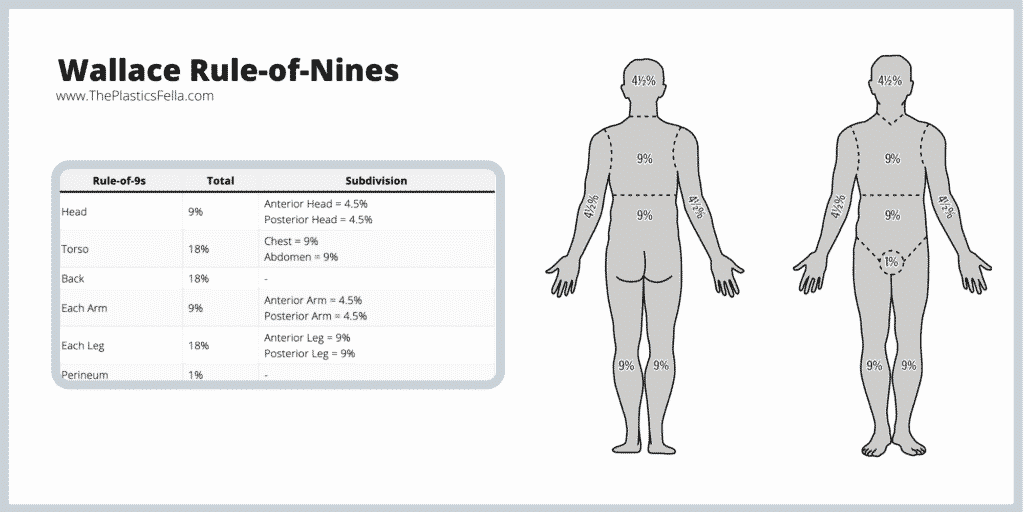Burn Chart Rule of Nines: Burn Percentage in Adults
What is the rule of nines for estimating burn percentage in adults? How accurate is this method compared to other techniques? How can healthcare providers improve assessment of burn surface area?
Estimating Burn Percentage with the Rule of Nines
The rule of nines is a widely used tool in trauma and emergency medicine to estimate the total body surface area (TBSA) affected by burns in adult patients. This simple method divides the body into sections, each representing approximately 9% of the total surface area. The head and each upper limb are each counted as 9%, the anterior trunk and posterior trunk are each 18%, and each lower limb is 18%.
This system provides a quick way for clinicians to assess the extent of a burn injury and guide fluid resuscitation and other treatment decisions. Accurate measurement of the initial burn area is crucial, as patients with severe burns will experience massive fluid losses due to disruption of the skin barrier.

Limitations of the Rule of Nines
While the rule of nines is widely used, research has shown it may not be the most reliable method for estimating TBSA. Studies have found significant variability in clinicians’ subjective assessments using this technique, with disagreement between providers on the extent of the burn area.
One study published in the Journal of Wound Care in 2023 evaluated medical professionals’ assessments of burn surface area in a plastic surgery unit. The researchers found “limited research has been carried out” on the accuracy of subjective burn area assessments, despite their importance in guiding treatment. They concluded that no standardized subjective assessment tools exist to measure burn surface area reliably.
Emerging Techniques for Burn Area Measurement
Given the limitations of the rule of nines, researchers have explored alternative methods for more objectively measuring burn TBSA. One approach is the use of three-dimensional imaging, which a 2018 study in Burns journal found had superior inter-observer reliability compared to the rule of nines and “palm method”.
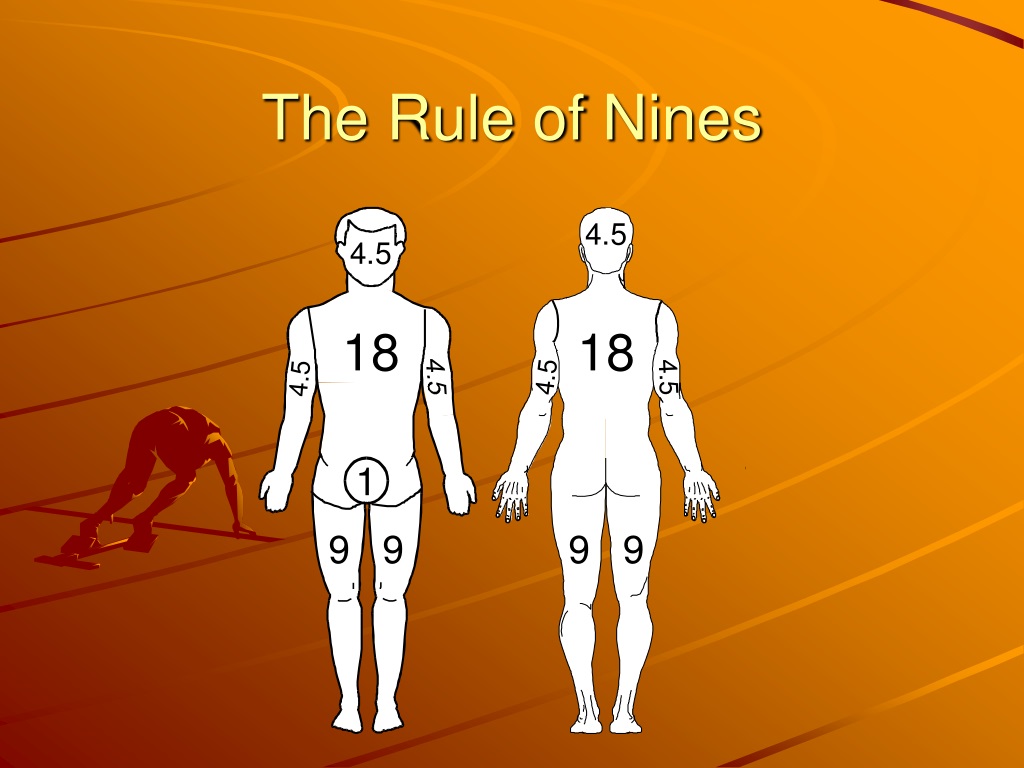
Another innovative technique is the EasyTBSA smartphone application, evaluated in a 2023 study published in the Emergency Medicine Journal. The researchers concluded the EasyTBSA app “may improve the estimation of TBSA compared with existing methods”.
Implications for Burn Care
Accurate assessment of burn surface area is critical for providing appropriate fluid resuscitation and other essential treatments. The limitations of the rule of nines highlight the need for more standardized, objective measurement techniques.
As research continues on new methods like 3D imaging and digital apps, healthcare providers will have access to tools that can improve the reliability and consistency of burn area assessments. This has important implications for optimizing care and outcomes for burn patients.
Future Directions in Burn Assessment
Beyond surface area, researchers are also exploring other factors that may impact burn severity and treatment, such as the significance of skin graft take following burn injuries. A 2022 study in Ulus Travma Acil Cerrahi Derg found that erectile dysfunction can be a long-term issue for patients with major burns, underscoring the importance of comprehensive follow-up care.
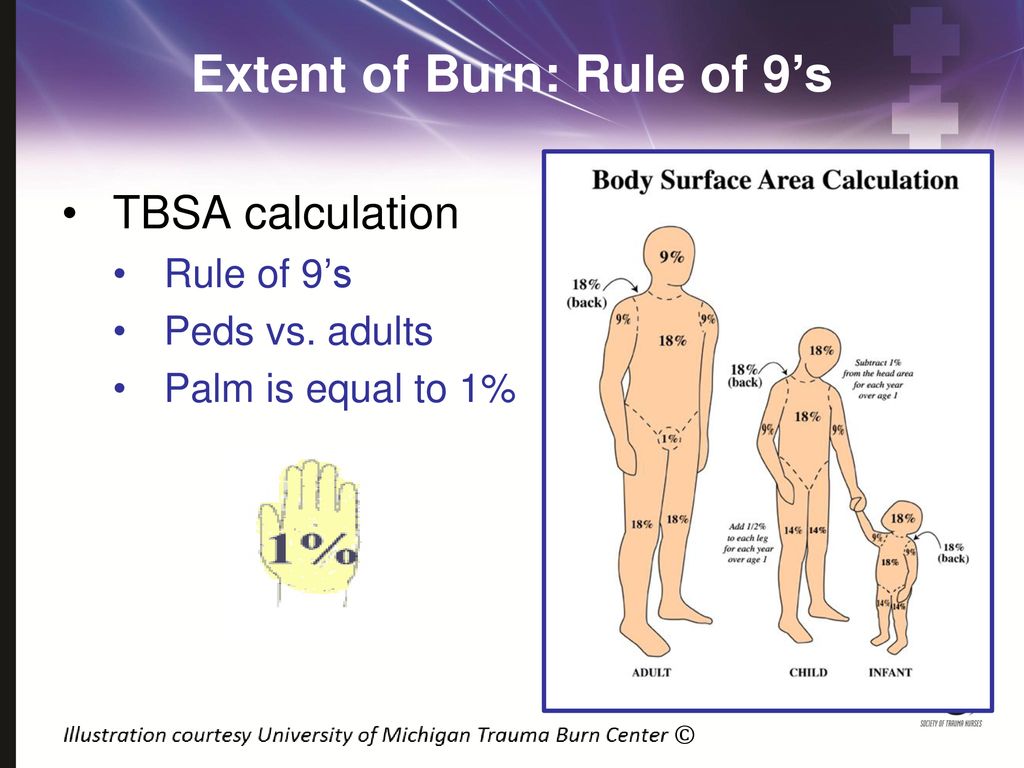
As the field of burn care continues to evolve, healthcare providers will need access to the latest evidence-based assessment techniques and tools. By improving the accuracy and reliability of burn evaluations, clinicians can make more informed decisions to support positive outcomes for their patients.
Conclusion
The rule of nines has long been a staple tool for estimating burn TBSA, but research indicates it may not be the most reliable method. Emerging techniques like 3D imaging and digital apps show promise for providing more objective and consistent assessments.
As the medical community works to advance burn care, improving the accuracy of surface area measurement will be a key priority. By leveraging the latest evidence-based approaches, healthcare providers can enhance their ability to guide appropriate treatment and support better outcomes for burn patients.
PRIME PubMed | rule of nines journal articles from PubMed
(rule of nines)
62 results
- Estimation of wound surface area: an evaluation of medical professionals’ assessment in a plastic surgery unit. [Journal Article]
J Wound Care. 2023 Jun 02; 32(6):376-382.Bovis JL, Walsh K, … Gilbert PMJW
- The percentage of skin graft take following the resurfacing of burn injuries is routinely calculated in a subjective fashion, in order to make management decisions. Given the gravity of decisions made based on this clinical assessment of graft check, it is notable that limited research has been carried out on this subject. No standardised subjective assessment tools exist to measure surface area …
- Publisher Full Text (DOI)
- EasyTBSA as a method for calculating total body surface area burned: a validation study. [Journal Article]
Emerg Med J. 2023 Apr; 40(4):279-284.Colson CD, Alberto EC, … Burd RSEM
- CONCLUSIONS: The EasyTBSA application may improve the estimation of TBSA compared with existing methods.

- Publisher Full Text (DOI)
- Erectile dysfunction in patients with major burn injury: The significance of follow-up. [Clinical Trial]
Ulus Travma Acil Cerrahi Derg. 2022 Nov; 28(11):1597-1603.Akdeniz F, Şekerci CA, … Çam KUT
- CONCLUSIONS: The current trial demonstrated that IIEF-5 scores of patients with major burn can show significant impairment in long term, and it seems a time-dependent process. This is the first prospective trial showing that IIEF can be utilized to monitor erectile function of burn patients in a longer follow-up program.
- Publisher Full Text (DOI)
- StatPearls: Rule of Nines [BOOK]
StatPearls. StatPearls Publishing: Treasure Island (FL)MooreRoss A.RASouthern Illinois University School of MedicineWaheedAbdulABurnsBrackenBEast Tennessee State University (ETSU)BOOK
- The Rule of Nines, also known as the Wallace Rule of Nines, is a tool used by trauma and emergency medicine providers to assess the total body surface area (TBSA) involved in burn patients.
 Measurement of the initial burn surface area is important in estimating fluid resuscitation requirements since patients with severe burns will have massive fluid losses due to the removal of the skin barrier.…
Measurement of the initial burn surface area is important in estimating fluid resuscitation requirements since patients with severe burns will have massive fluid losses due to the removal of the skin barrier.…
- In severe necrotising soft-tissue infections, do skin defect surfaces matter? [Letter]
Anaesth Crit Care Pain Med. 2022 06; 41(3):101071.Tanaka S, Thy M, … Montravers PAC
- Publisher Full Text (DOI)
- Body mapping chart for estimation of percentage of body surface area in mesocephalic dogs. [Journal Article]
J Vet Emerg Crit Care (San Antonio). 2022 May; 32(3):350-355.Henriksson A, Kuo K, … Moon RJV
- CONCLUSIONS: A chart for estimating canine body surface was created. Given the diversity of dog breeds, sizes, and body conformation, our results cannot be generalized to all dogs. Studies of more diverse populations are warranted.
- Publisher Full Text (DOI)
- Three-dimensional imaging is a novel and reliable technique to measure total body surface area.
 [Journal Article]
[Journal Article]Burns. 2018 06; 44(4):816-822.Rashaan ZM, Euser AM, … Breederveld RSB
- CONCLUSIONS: The inter-observer reliability of three-dimensional imaging was superior compared with the rule of nines and palm method.
- Publisher Full Text (DOI)
New SearchNext
56 Evaluation of a Smartphone Application as a Method for Calculating Total Body Surface Area Burned | Journal of Burn Care & Research
Journal Article
Cindy D Colson, MSN, RN,
Cindy D Colson, MSN, RN
Search for other works by this author on:
Oxford Academic
Google Scholar
Emily A Alberto, MD,
Emily A Alberto, MD
Search for other works by this author on:
Oxford Academic
Google Scholar
Zachary P Milestone, BA,
Zachary P Milestone, BA
Search for other works by this author on:
Oxford Academic
Google Scholar
Nikita Batra, BS,
Nikita Batra, BS
Search for other works by this author on:
Oxford Academic
Google Scholar
Tyler Salvadore, BS,
Tyler Salvadore, BS
Search for other works by this author on:
Oxford Academic
Google Scholar
Hadi Fooladi, MS,
Hadi Fooladi, MS
Search for other works by this author on:
Oxford Academic
Google Scholar
Kevin Cleary, PhD,
Kevin Cleary, PhD
Search for other works by this author on:
Oxford Academic
Google Scholar
Rima Izem, PhD,
Rima Izem, PhD
Search for other works by this author on:
Oxford Academic
Google Scholar
Randall S Burd, MD, PhD
Randall S Burd, MD, PhD
Search for other works by this author on:
Oxford Academic
Google Scholar
Journal of Burn Care & Research, Volume 43, Issue Supplement_1, April 2022, Pages S38–S39, https://doi. org/10.1093/jbcr/irac012.059
org/10.1093/jbcr/irac012.059
Published:
23 March 2022
Navbar Search Filter
Journal of Burn Care & ResearchThis issueSurgeryBooksJournalsOxford Academic
Mobile Enter search term
Close
Navbar Search Filter
Journal of Burn Care & ResearchThis issueSurgeryBooksJournalsOxford Academic
Enter search term
Advanced Search
Introduction
Current methods of burn estimation can lead to incorrect estimates of the total body surface area burned, especially among injured children. Inaccurate estimation of burn size can impact initial management, including unnecessary transfer to burn centers and fluid overload during resuscitation. To address these challenges, we developed a smartphone application that calculates the total body surface area of a burn using a body-part by body-part approach. The aims of this study were to assess the accuracy of the smartphone application and compare its performance to three established methods of burn size estimation (Lund-Browder Chart, Rule of Nines, Rule of Palms).
Inaccurate estimation of burn size can impact initial management, including unnecessary transfer to burn centers and fluid overload during resuscitation. To address these challenges, we developed a smartphone application that calculates the total body surface area of a burn using a body-part by body-part approach. The aims of this study were to assess the accuracy of the smartphone application and compare its performance to three established methods of burn size estimation (Lund-Browder Chart, Rule of Nines, Rule of Palms).
Methods
Twenty-four healthcare providers used each method to estimate burn sizes on moulaged manikins. The manikins represented different ages (infant, child, adult) with different total body surface area burns (small < 20%, medium 20-49%, large >49%). We calculated the accuracy of each method as the difference between the user-estimated and actual total body surface area. We used multivariable modeling to control for manikin size and method.
Results
Among all age groups and burn sizes, the smartphone application had the greatest accuracy for burn size estimation (-0. 01%, SD 3.59%) followed by the Rule of Palms (3.92%, SD 10.71%), the Lund-Browder Chart (4.42%, SD 5.52%), and the Rule of Nines (5.05%, SD 6.87%).
01%, SD 3.59%) followed by the Rule of Palms (3.92%, SD 10.71%), the Lund-Browder Chart (4.42%, SD 5.52%), and the Rule of Nines (5.05%, SD 6.87%).
Conclusions
The smartphone application may improve the estimation of total body surface area burned compared to existing methods.
This content is only available as a PDF.
© The Author(s) 2022. Published by Oxford University Press on behalf of the American Burn Association.
This is an Open Access article distributed under the terms of the Creative Commons Attribution License (https://creativecommons.org/licenses/by/4.0/), which permits unrestricted reuse, distribution, and reproduction in any medium, provided the original work is properly cited.
Issue Section:
C-251 Correlative VII: Clinical Sciences: Wounds & Scars 1
Download all slides
Advertisement
Citations
Altmetric
More metrics information
Email alerts
Article activity alert
Advance article alerts
New issue alert
Receive exclusive offers and updates from Oxford Academic
Citing articles via
-
Latest
-
Most Read
-
Most Cited
A Regional Analysis of Potentialy Preventable Injuries Sustained from Burning Garbage and Yard Waste
Working Towards Holistic Scar Assessment and Improved Shared Decision-Making in Global Burn Care
Insignificant difference in early post-injury gene expression between patients with burns only and those with inhalation injury: A bioinformatics analysis
Evaluation of the Role of a Clinical Pharmacist on Medication Management in an Adult Burn Clinic via a Collaborative Drug Therapy Management Protocol
An Observational Study Of Knowledge Of First Aid For Burns Among Parents In Indonesia
Academic Surgical Pathologist/Breast Pathologist
, Utah
Director, Clinical Research Computing Unit (CRCU) (Standing Faculty Sr. Ranks)
Ranks)
Philadelphia, Pennsylvania
Autopsy Pathologist and CLIA Medical Director Leadership Opportunity University of Vermont Health Network
, Vermont
ACADEMIC SURGICAL PATHOLOGIST
, Vermont
View all jobs
Advertisement
A burn is tissue damage resulting from exposure to high temperatures or chemicals. A thermal burn can be obtained not only during a fire, but also at home: by accidental contact with a hot frying pan, a boiling kettle, and even sunbathing on the beach for a long time. A chemical burn can be caused by accidental contact with alkali, acid, salts of heavy metals on the skin. Burns are one of the most common traumatic injuries and are the second leading cause of death. First aid for burns Burn – tissue damage caused by local thermal (thermal), chemical, electrical or radiation exposure. The most common are thermal burns resulting from exposure to high temperatures (flame, hot steam, boiling liquids, red-hot metal). Degrees of burnsThere are four degrees of burns:
The severity of the burn is determined depending on the depth of the lesion and on the area at the same time. In addition to violation of the integrity of the skin, large burns are accompanied by general phenomena, such as shock, toxemia, damage to the nervous and vascular systems, loss of blood plasma. Regardless of the degree, burns of 25% of the body surface are very dangerous; burns on half the surface of the body are often fatal. With deep burns, pain may be absent due to damaged nerve endings. “First Aid for Burns” is a very useful training video that you will always know what to do in case of skin burns. Many, for sure, know that the degrees of these same burns are different. Of course, if a large part of the body is affected, it is best to call an ambulance, but if the wound is not very serious, then our specific knowledge on this matter may be required. Our video will help you find them! First aid for burns Burns are thermal, chemical and radiation. Thermal burns occur when the skin or mucous membranes (integumentary tissues) are exposed to high temperature, the source of which is a flame, hot objects and liquids, hot gaseous substances, combustible substances, etc. Thermal burns – severe injuries, leading in some cases to disability and even death. They can be observed at work, but much more often we are faced with household lesions. The severity of a burn depends on the area and depth of tissue damage. The prognosis for burns is determined, in addition to the area and depth of tissue damage already mentioned, by the presence of burn shock and its duration, the degree of damage to the respiratory tract, the age of the victim, the nature of concomitant diseases and, of course, the time to start adequate treatment. There are five degrees of skin damage in burns: I degree – redness and swelling of the skin at the site of the lesion; II degree – damage to the stratum corneum with detachment and blistering immediately after the burn; IIIA degree – partial necrosis of the skin. These are the so-called superficial burns. Deep burns include: IIIB degree burns, in which there is a complete death of the skin of the skin itself; fourth degree burns – necrosis of the skin and deep-lying tissues, down to the bone. Superficial burns heal almost spontaneously. With deep burns, dead tissues are rejected, followed by filling the defect. The depth of the lesion has several degrees: I degree – redness and swelling of the skin and mucous membranes; II degree – the formation of blisters filled with a light yellow liquid, the blisters are small, the area around the edema is small; IIIA degree – large tense blisters, the wall of which, as a rule, is torn, the bottom of the wound is pink, moist. Pain sensitivity at the bottom of the bladder is preserved or reduced. In later periods, a light yellow scab may form, sometimes with a brown and gray tint; IIIB degree – a bubble with clearly bloody contents, its wall is most often destroyed, the bottom is dry, whitish, with separate pale spots, sometimes with a marble pattern. Pain sensitivity is reduced or absent, the scab, if it forms, is dark or brown; IV degree – a characteristic black or brown scab, under which thrombosed veins can be translucent, underlying tissues (muscles, tendons, etc. The area of the burn and the total area of the lesion are calculated as a percentage of the total surface area of the human body according to the rule of nines and the rule of the palm. According to the rule of nines in adults, the surface area of individual parts of the body and limbs (head and neck; chest; abdomen; shins and feet; hips; back; lower back and buttocks) accounts for 9% of the surface of the entire body (or this figure is a multiple of 9%) , only the surface area of the external genitalia and perineum is 1%. In children, to determine the burn area, a modified rule of nines is recommended, which gives a reliable result with an error of no more than + 5% (Table 1). Table 1. Localization (location) of a burn area in children According to the rule of the palm, the area of the burn is defined as follows: the area of the palm of an adult is taken as 1% of the area of the whole body. In practice, both of these methods are used. For small burns, the rule of the palm is used, for large burns, the rule of nines, and individual minor lesions are measured according to the rule of the palm, after which everything is summed up. Determination of the severity of a burn Minor burns – less than 5% of the body surface affected. Moderate burns – less than 20% of the body surface is affected, and deep burns are no more than 10%. Severe burns – from 20 to 60% of the body surface is affected, while deep burns account for no more than half. Extremely severe burns – more than 60% of the body surface suffers, more than half are deep burns. Minor burns in adults can be treated on an outpatient basis. Treatment of children requires an individual approach depending on the location of the lesion. All other burns are subject to treatment in specialized hospitals. The prognosis depends on early diagnosis and early effective treatment of burn shock. Almost always, with a burn area of 15-20% or more and a deep burn over 10% of the body surface area, burn shock develops. The degree of its severity also depends on the area of the burn: if it is less than 20% of the body surface, then they speak of mild shock, from 20 to 60% – severe, more than 60% – extremely severe. These degrees can pass one into another, depending on the characteristics of the course of shock in each case and the time of onset and intensity of treatment. For the early diagnosis of burn shock, the following clinical manifestations and symptoms are important: the victim is agitated or inhibited, consciousness is confused or absent at all, the skin and mucous membranes (outside the burn) are pale, cold, cyanosis of the mucous membranes and extremities is pronounced, the pulse is increased, shortness of breath, vomiting, thirst , chills, muscle tremors, muscle twitching, urine of a dark color, up to brown, its amount decreases sharply – a characteristic sign of burn shock. In children, the signs of burn shock are mild, which causes difficulties in early diagnosis. First of all, weakness, lethargy, cyanosis of the skin, cold extremities, muscle tremors, and vomiting are noted. Anti-shock treatment is required for all children with burns over 10% of the body surface and children under 3 years of age with burns over 5% of the body surface. In the elderly, burn shock occurs against the background of a variety of concomitant diseases (diabetes mellitus, heart failure, liver disease, etc.) that affect its outcome. Therefore, antishock treatment is carried out for all victims over 60 years of age with superficial burns of more than 10% and deep burns of more than 5-7% of the body surface. Significantly increases the risk of burn shock burns of the respiratory tract caused by inhalation of hot air, steam, smoke, etc. Respiratory burns should be suspected if the victim was in an enclosed area or confined space at the time of the fire. When providing first aid for a burn, the burn surface is not treated. Apply an aseptic dressing or a special anti-burn dressing, if available. It is allowed to use a wet-drying dressing with antiseptics or antibiotics. For mild burns, the treatment of which can be outpatient, after preliminary anesthesia (1-2 ml of a 1% solution of promedol), the toilet of the burn wound is performed: the skin around the burn is wiped with a 0. Further, burn surfaces, with the exception of lesions of the face and perineum, are treated with a closed method. For superficial burns up to 30% of the body surface area, dressings with low-fat creams, Vishnevsky ointments, synthomycin emulsion, solutions of furacillin, chloracil, antibiotics in a 0.5% solution of novocaine (monomycin, kanamycin, polymyxin, etc.) can be used. 1st degree burns heal in 3-4 days, 2nd degree burns in most cases in 10-14 days if there is no suppuration. With suppuration, the dressings are changed after 6-8 days, soaking them in a weak solution of potassium permanganate. For burns of the face, neck, perineum, II degree bandages are not applied. After washing the wounds, their surface is generously lubricated 2-4 times a day with vaseline oil, synthomycin or streptocidal emulsions. In this case, brownish burn scabs are formed, which should be removed only after their complete rejection. Second degree facial burns usually heal within 12 days. Local measures for IIIA degree burns in the first 7-8 days do not differ from those for II degree burns. With suppuration, the surgeon continues the treatment of the patient.
Frostbite, frostbite. Symptoms, recipes, recommendations for the treatment of frostbite Frostbite (frostbite) can occur not only at outside temperatures below zero, but also at temperatures of 4-8 degrees Celsius, and sometimes even higher. Its development is facilitated by wind, air humidity, damp and tight clothing, shoes, alcohol intoxication, weakening of the body. There are four degrees of frostbite . At grade 1 the skin turns pale, loses sensitivity, frostbitten areas often swell, pain and itching appear; after warming, the skin on the affected area turns red, then swells and after a while begins to peel off. All these phenomena pass in 2-3 days. At 2nd degree – the same phenomena occur, but after a while bubbles appear, filled with a clear liquid. As a rule, the blisters dry up after 10-12 days, recovery occurs after 2-3 weeks. At grade 3 , skin necrosis is noted, blisters are filled with bloody fluid, deep tissue lesions develop 7-10 days after exposure to cold. At grade 4 there is necrosis of all soft tissues, and sometimes even bone tissue. The victim should be immediately brought into a warm room (with a temperature of 18-20 °), give him hot tea or coffee, wash the affected area with warm water and soap, vodka, alcohol or cologne so as not to introduce an infection when rubbing, then drain and start carefully rub (cleanly washed hands, slightly moistened with cologne or vodka) until the skin turns red. Lubricating the skin, especially the legs, with fats does not prevent frostbite, but, on the contrary, may contribute to its occurrence.
Wind-corrected ambient temperature
| |||||||||||||||||||||||||||||||||||||||||||
Rule of nines for burns and other area methods 90 002
A burn is a violation of the integrity of the skin or mucous membranes as a result of exposure to thermal, chemical, electrical stimuli.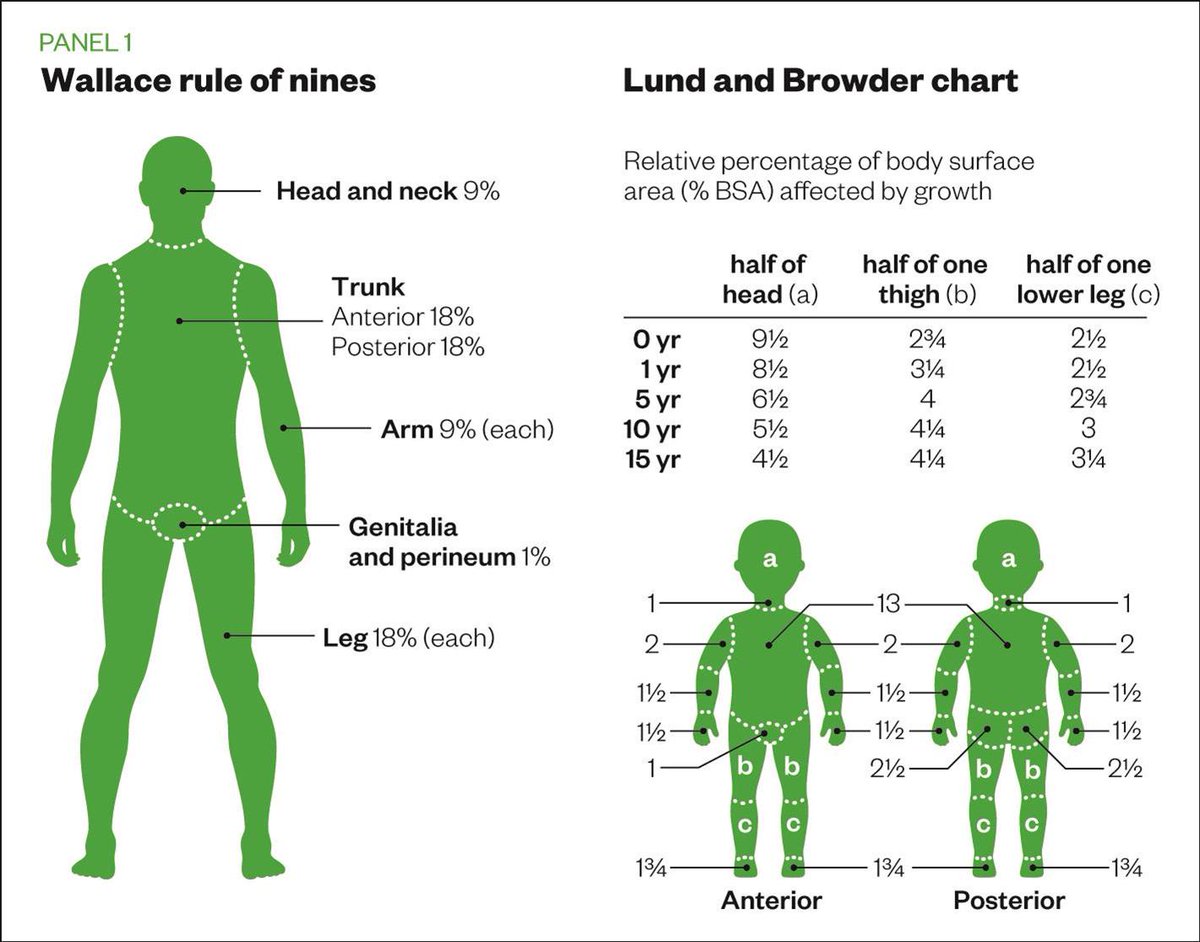 According to the international classification of diseases (ICD-10), the disease code is T20-T32. For diagnosis and treatment, it is necessary to determine the depth and area of damage. To do this, apply the rule of nines for burns.
According to the international classification of diseases (ICD-10), the disease code is T20-T32. For diagnosis and treatment, it is necessary to determine the depth and area of damage. To do this, apply the rule of nines for burns.
Contents
- What rules can determine the degree and area of a burn
- Rule of nines
- Rule of the palm
- Postinkov method
- Efficiency and accuracy of determination according to the method data m
What rules can determine the degree and area of the burn
The degree of burn is the depth of the wound, which is determined visually and is related to the extent of skin damage. The human skin is made up of 3 layers: epidermis, dermis, and hypodermis.
- epidermis – the top layer of the skin that protects the human body from the harmful effects of the environment;
- dermis – an intermediate layer between the epidermis and hypodermis, represented by connective tissue;
- The hypodermis is represented by adipose tissue, in which connective tissue and blood vessels are located.

Each degree in the table represents damage to a certain layer (or several layers) of the skin.
| Degree of burn and its type | Characteristic |
| First (surface) | Slight damage to the epidermis. Characterized by redness, swelling, pain. The healing period is no more than a week. After overgrowth of the epithelium, scars and scars do not appear. |
| Second (surface) | The hypodermis is not affected. A distinctive feature is the formation of blisters with a clear exudate. Healing time is 1-2 weeks, depending on the severity. Scars or scars are not formed, pigmentation may appear, which will disappear after 14-21 days. |
| Third A (surface) | The epidermis is completely affected, the dermis layer is partially affected, including the sebaceous, sweat glands. Large blisters form, scabs appear, pain sensitivity is reduced. The healing period is over 2 weeks. The wound will heal faster if there is no infection. The wound will heal faster if there is no infection. |
| Third B (deep) | Complete damage to the epidermis, dermis. Reduced pain sensitivity, skin necrosis occurs. Heals for a long time, with a high probability of scarring or scars. |
| Fourth (deep) | Carbonization of tissues, destruction of the epidermis, dermis, hypodermis up to the musculoskeletal tissue. When the wound becomes infected, complications in the form of a burn disease are likely. If left untreated, there is a high chance of death. |
Superficial burns heal up to 2 weeks in the absence of infection. Treatment of deep wounds is carried out by transplantation of skin-fat grafts.
Fatal injuries over 60% of the body, and for people over 60 years old – over 40%.
The area of burns is determined using the rule of nines, the palm, the Postnikov method, the Dolinin, Vilyavin, Land-Browder methods (the latter are not currently used).
The Rule of Nines
The Rule of Nines for burns was first studied in the 1950s by the researcher Wallace. The technique involves delimiting the body into sections, each corresponds to 9%.
| Body area | Percentage |
| Head and neck | 9% |
| Upper limb (arm) | 9% |
| Front torso (chest+abdomen) | 9%+9%=18% |
| Back torso (back) | 9%+9%=18% |
| Leg (shin+thigh+foot) | 9%+9%=18% |
| External genitalia | 1% |
Wallace’s rule gives an approximate percentage, is not difficult to use. Treatment of injuries is effective in the early stages, the size of the lesion should be quickly determined. Knowing the principle of nines in an emergency will allow you to orient yourself, provide first aid.
Rule of the palm
The method was first studied in the 50s of the twentieth century by the researcher I.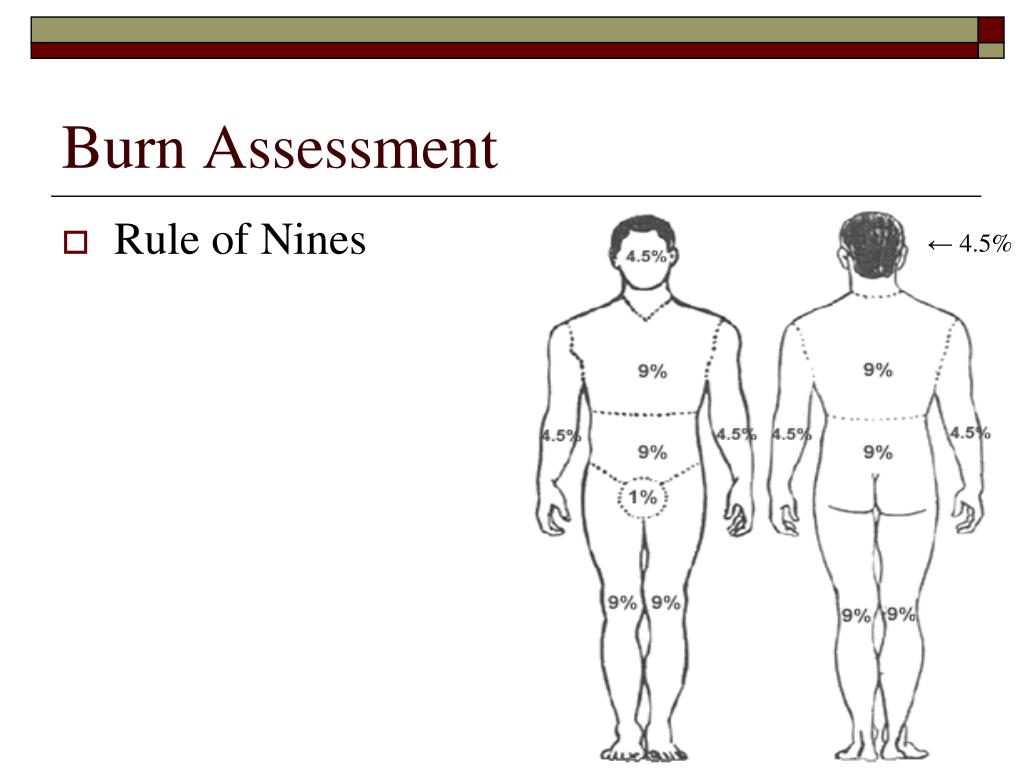 Glumov. The palm rule for burns is based on the belief that a person’s hand equals 1% damage.
Glumov. The palm rule for burns is based on the belief that a person’s hand equals 1% damage.
The given palm rule is used for adults. For children, the percentage depends on age.
So, at 1 year old, the palm of a child occupies 9% of the body, the leg – 14%, the front surface of the body (chest, abdomen) – 36%, the head and neck – 18%. For children 5 years old, the proportion is already different: hand – 9%, leg – 16%, torso in front (chest, abdomen) – 36%, head and neck – 14%.
Postinkov method
A gauze bandage is applied to the burned area of the body, and a sketch of the injury is made. Next, the drawing is transferred to graph paper, in this way the size of the lesion is determined. The technique is accurate, rarely used due to the complexity and duration of the implementation, graph paper is not always at hand.
The Land-Browder method is used to determine the severity of the wound in children under one year of age. It is based on the principle of the following ratio: head, neck – 21%, front, back surface of the body – 16%, lower limb – 14%, genitals – 1%.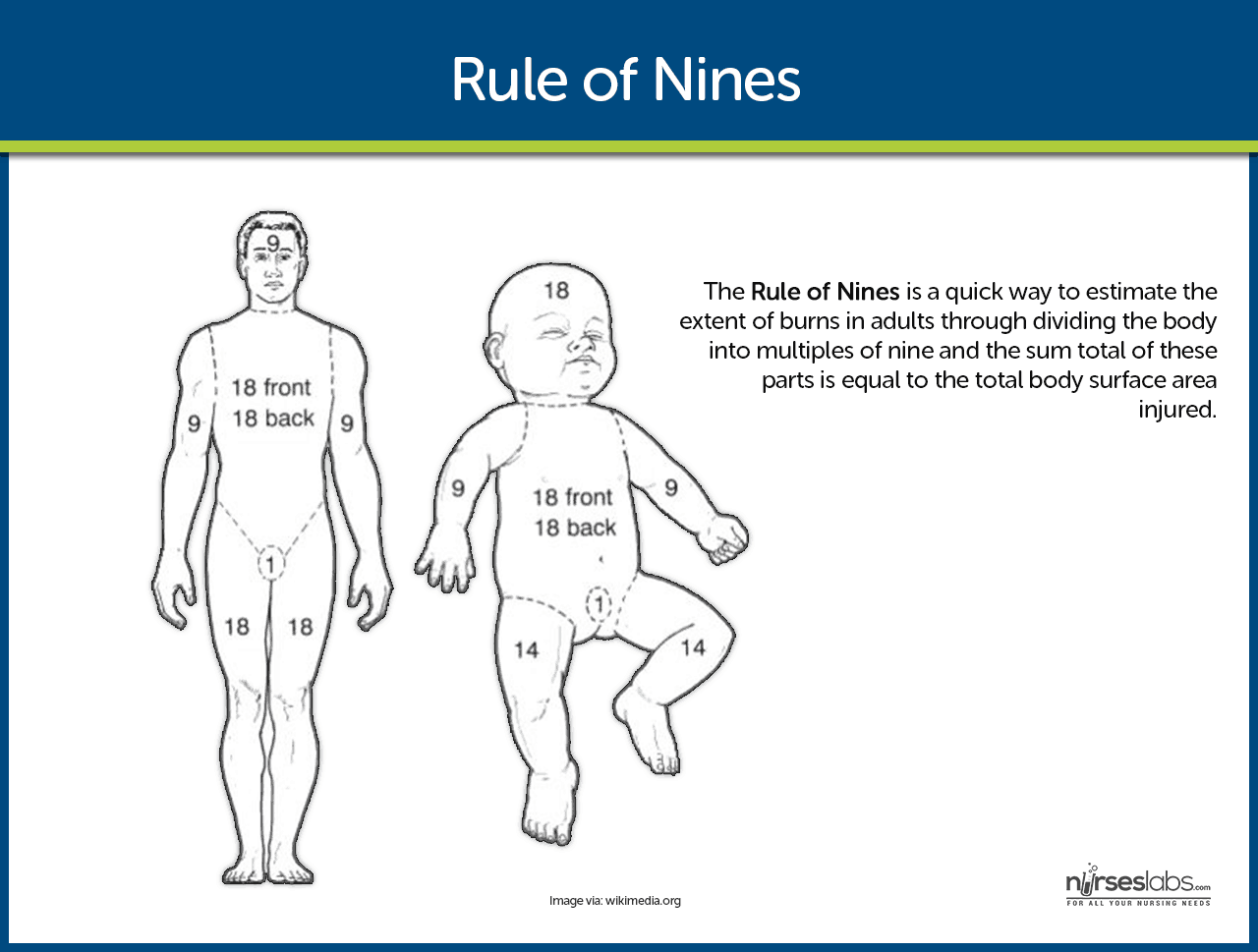
Efficiency and accuracy of determination by these methods
For large lesions, the method of nines is used, and if the person was burned slightly, it is faster to find out the percentage of damage using the palm method.
The listed methods for determining the area of a burn do not give an accurate result, the size of body parts is different for each person. So, there are asthenic, normosthenic, hypersthenic body types. The limbs also have different lengths. Throughout life, a person gains weight, due to this, the algorithm for calculating the size of each part of the body changes.
The depth and size of the wound determine further treatment. To find out the degree of complexity of a burn injury, one should calculate the Frank index – one of the integral indicators.
| Grade | Point |
| 1 | 0.5 |
| 2 | 1 |
| 3A | 2 |
| 3B | 3 |
| 4 | 4 |
The sum of indices obtained in this way constitutes the degree of injury.


 Measurement of the initial burn surface area is important in estimating fluid resuscitation requirements since patients with severe burns will have massive fluid losses due to the removal of the skin barrier.…
Measurement of the initial burn surface area is important in estimating fluid resuscitation requirements since patients with severe burns will have massive fluid losses due to the removal of the skin barrier.… [Journal Article]
[Journal Article] org/10.1093/jbcr/irac012.059
org/10.1093/jbcr/irac012.059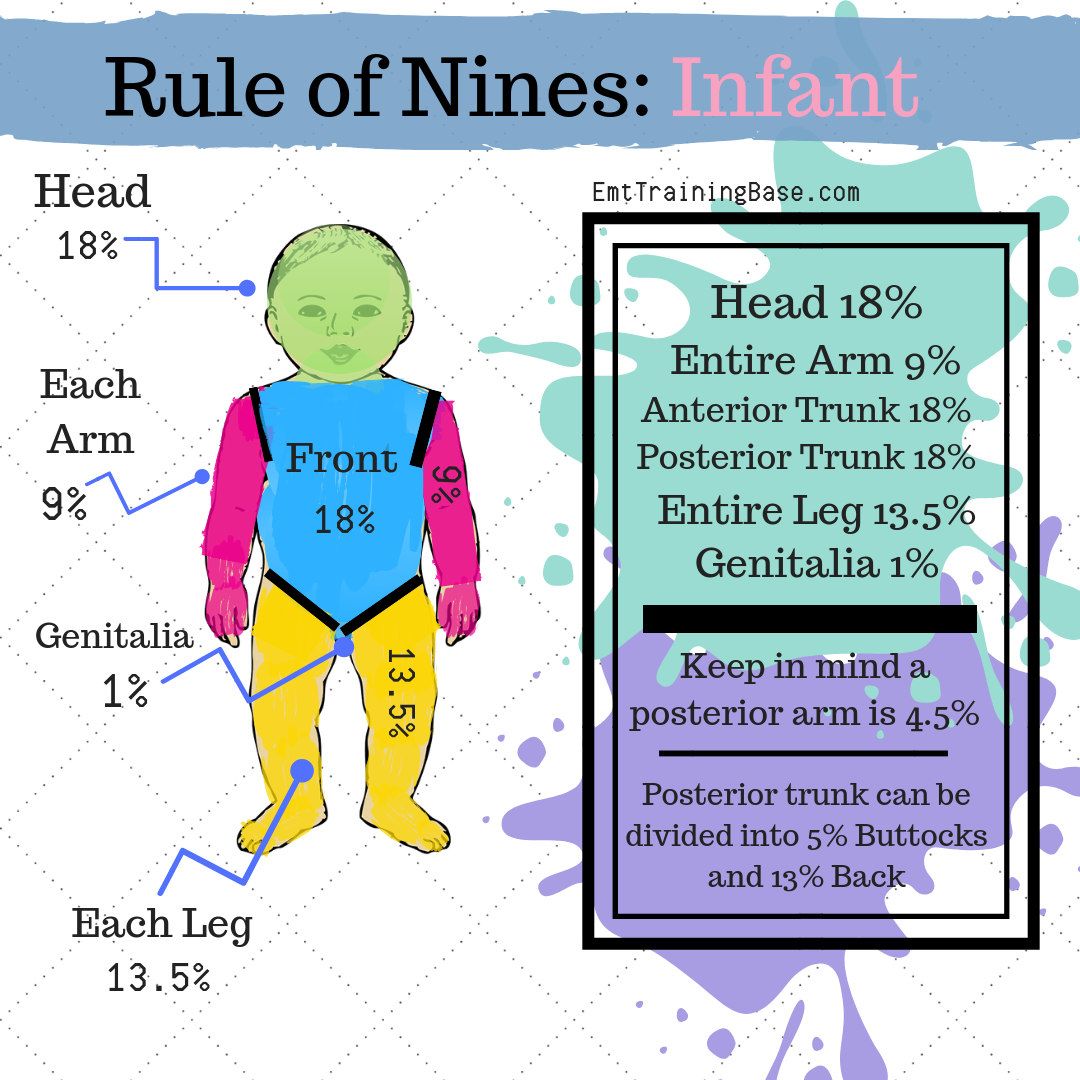 That is why every person should know what to do with a burn in order to minimize the possible consequences of the injury, and also have an idea of the classification of burns according to the degree of damage and the severity of such an injury.
That is why every person should know what to do with a burn in order to minimize the possible consequences of the injury, and also have an idea of the classification of burns according to the degree of damage and the severity of such an injury.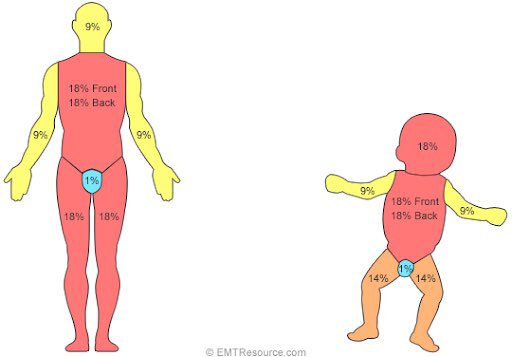
 Get useful skills with us!
Get useful skills with us!
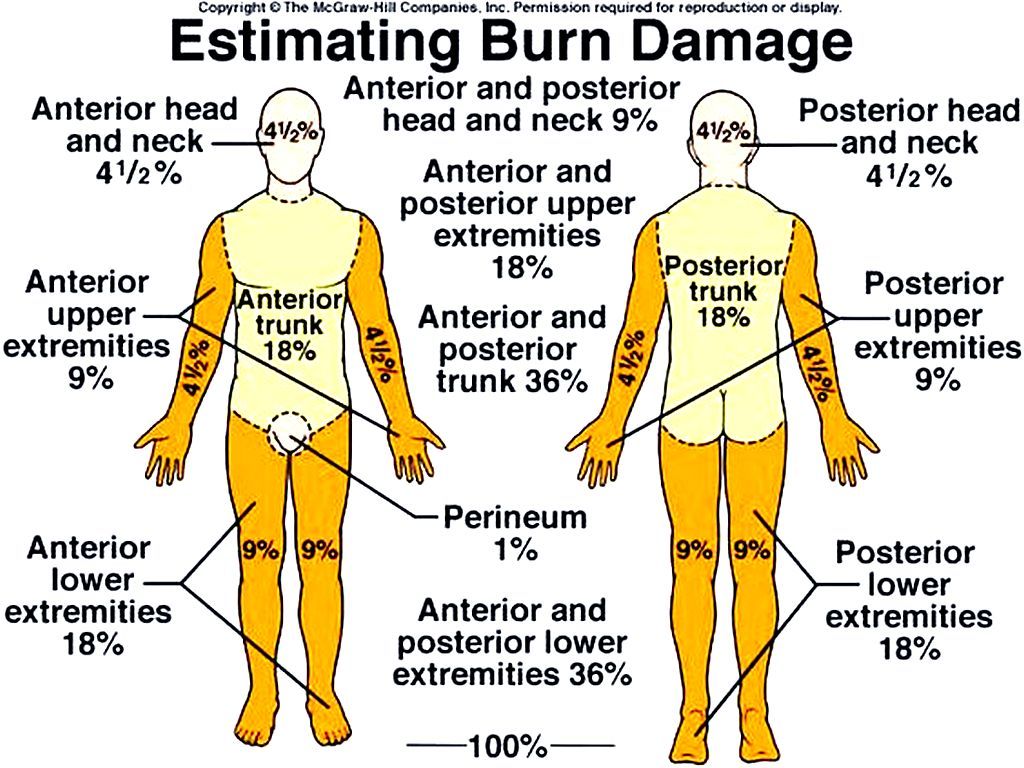 ) are affected. In the first days after the burn, it is difficult to judge the true depth of the lesion, this can only be done after the scab is rejected. When providing first aid, the depth of the lesion is determined approximately, while it is better to assume its greater degree.
) are affected. In the first days after the burn, it is difficult to judge the true depth of the lesion, this can only be done after the scab is rejected. When providing first aid, the depth of the lesion is determined approximately, while it is better to assume its greater degree. Determination of burn area (in wacko in children
Determination of burn area (in wacko in children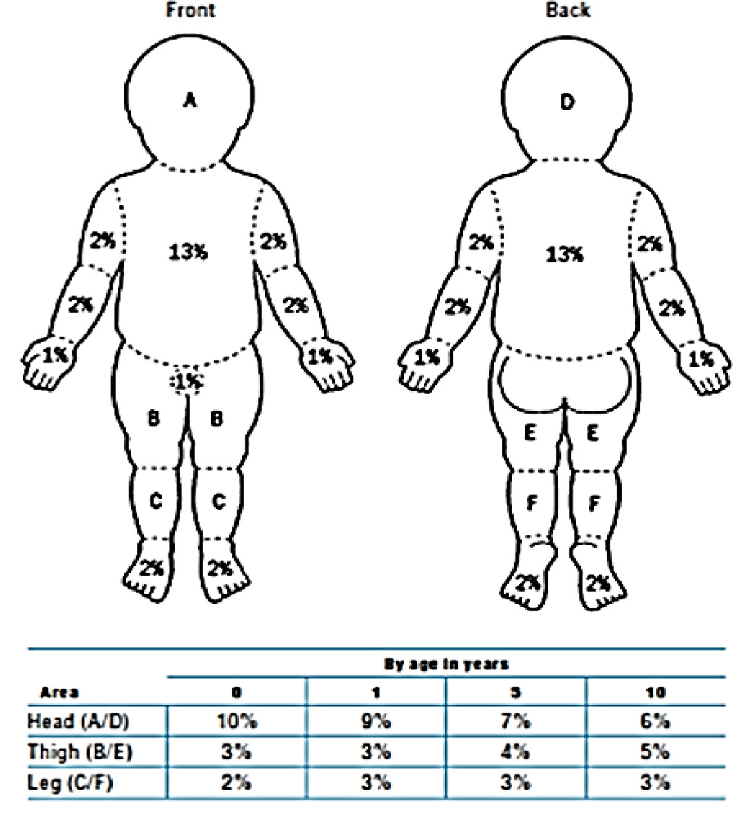
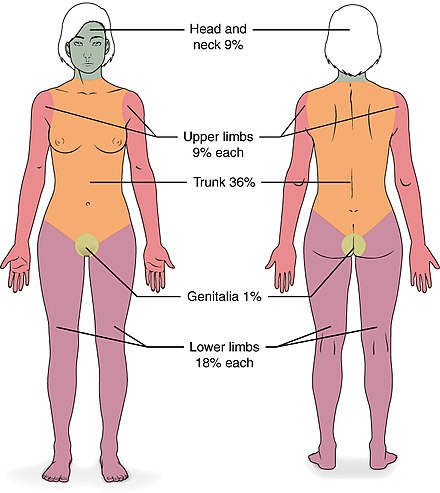 Unlike traumatic shock, burn shock cannot be recognized in the early period on the basis of a decrease in blood pressure and pulse rate. Blood pressure usually does not drop significantly and may even be elevated; its sharp decrease in burns is a poor prognostic sign.
Unlike traumatic shock, burn shock cannot be recognized in the early period on the basis of a decrease in blood pressure and pulse rate. Blood pressure usually does not drop significantly and may even be elevated; its sharp decrease in burns is a poor prognostic sign.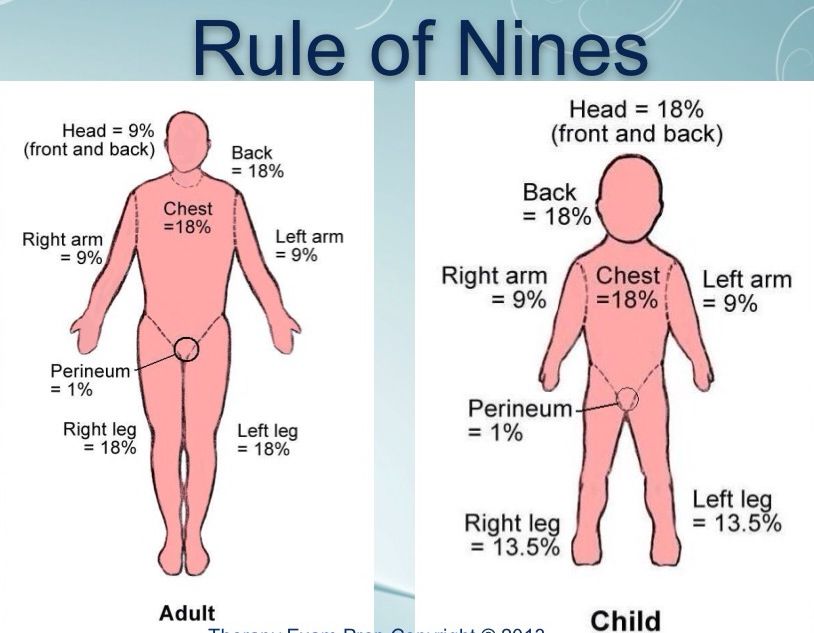
 In addition, a burn of the nose, lips or tongue, singed hair testifies to a burn of the respiratory tract. Examination of the oral cavity reveals redness and blisters on the soft palate and pharyngeal wall. There are also sore throat, hoarseness of voice, difficulty breathing. The final diagnosis of a burn of the respiratory tract is made by an otolaryngologist. With a combination of a skin burn and a burn of the respiratory tract, burn shock can occur with a lesion area half as large as with a skin burn alone. It is believed that a burn of the respiratory tract has the same effect on the affected person as a deep burn of the skin with an area of \u200b\u200babout 10-12% of the body surface.
In addition, a burn of the nose, lips or tongue, singed hair testifies to a burn of the respiratory tract. Examination of the oral cavity reveals redness and blisters on the soft palate and pharyngeal wall. There are also sore throat, hoarseness of voice, difficulty breathing. The final diagnosis of a burn of the respiratory tract is made by an otolaryngologist. With a combination of a skin burn and a burn of the respiratory tract, burn shock can occur with a lesion area half as large as with a skin burn alone. It is believed that a burn of the respiratory tract has the same effect on the affected person as a deep burn of the skin with an area of \u200b\u200babout 10-12% of the body surface. 25% or 0.5% solution of ammonia, warm soapy water or antiseptic solution, after which they are treated with alcohol or iodonate solution. Then wipe with a swab moistened with an antiseptic solution (furacillin 1:5000, chloracil, rivanol), then with a 0.25% solution of novocaine and carefully remove extraneous layers, foreign bodies, scraps of the surface layer of the skin. Whole bubbles are not removed. Very tense bubbles strike at the base.
25% or 0.5% solution of ammonia, warm soapy water or antiseptic solution, after which they are treated with alcohol or iodonate solution. Then wipe with a swab moistened with an antiseptic solution (furacillin 1:5000, chloracil, rivanol), then with a 0.25% solution of novocaine and carefully remove extraneous layers, foreign bodies, scraps of the surface layer of the skin. Whole bubbles are not removed. Very tense bubbles strike at the base.
 Frostbite most often fingers and toes, face, ears.
Frostbite most often fingers and toes, face, ears. You can not rub the frostbitten place in the cold or snow. If some time has passed after frostbite and blisters have appeared, it is necessary to apply a dry warming bandage and consult a doctor. In case of frostbite of a large area of the leg or arm, as well as in case of general freezing, it is best to take a bath (water temperature is not higher than 37 °), wash off the dirt and then rub and massage in clean water (in both cases, rub and massage also a healthy leg or hand). Instead of a bath, you can wipe your body with vodka or cologne, do a full body massage, drink hot, strong tea, coffee or vodka. If the victim is not breathing, give artificial respiration. In case of large areas of frostbite or frostbite III and IV degrees, as well as general freezing, first aid should be provided and the victim should be taken to a medical facility as soon as possible.
You can not rub the frostbitten place in the cold or snow. If some time has passed after frostbite and blisters have appeared, it is necessary to apply a dry warming bandage and consult a doctor. In case of frostbite of a large area of the leg or arm, as well as in case of general freezing, it is best to take a bath (water temperature is not higher than 37 °), wash off the dirt and then rub and massage in clean water (in both cases, rub and massage also a healthy leg or hand). Instead of a bath, you can wipe your body with vodka or cologne, do a full body massage, drink hot, strong tea, coffee or vodka. If the victim is not breathing, give artificial respiration. In case of large areas of frostbite or frostbite III and IV degrees, as well as general freezing, first aid should be provided and the victim should be taken to a medical facility as soon as possible.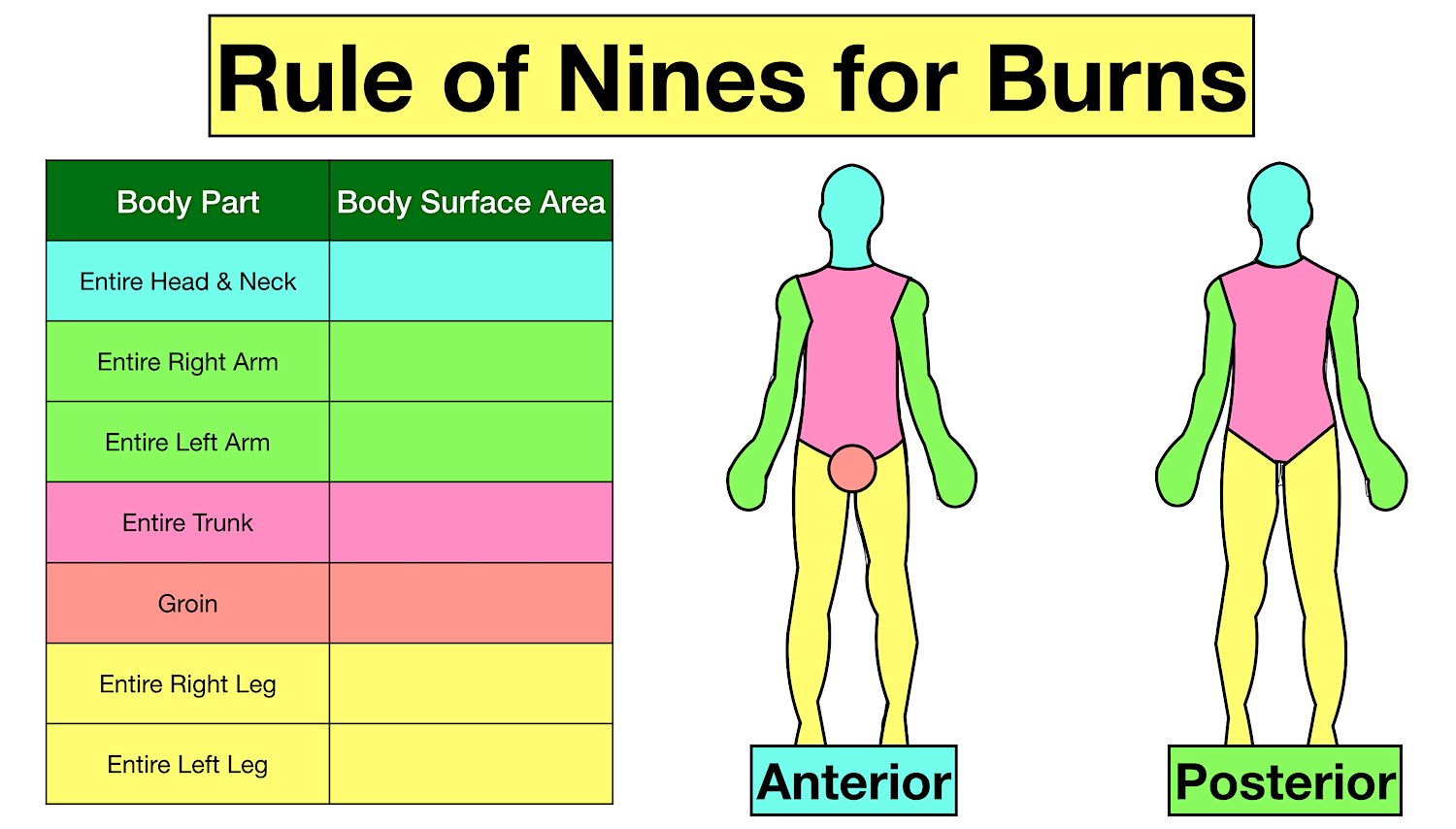 Response of the human body to a decrease in body temperature.
Response of the human body to a decrease in body temperature.  Indifference, inability to assess their actions.
Indifference, inability to assess their actions.